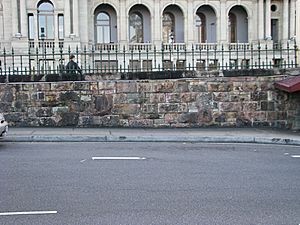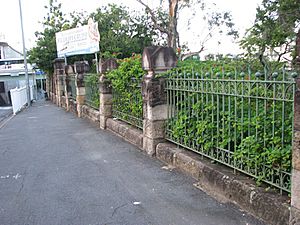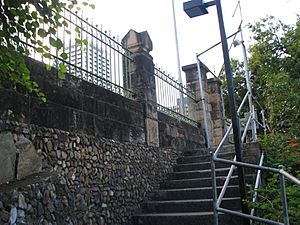William Street retaining wall facts for kids
Quick facts for kids William Street retaining wall |
|
|---|---|

William Street retaining wall (seen from Queens Wharf Road), 2008
|
|
| Location | William Street, Brisbane City, City of Brisbane, Queensland, Australia |
| Design period | 1870s - 1890s (late 19th century) |
| Built | 1889 - 1970s |
| Official name: William Street and Queens Wharf Road retaining walls, North Quay porphyry wall | |
| Type | state heritage (built) |
| Designated | 21 October 1992 |
| Reference no. | 600135 |
| Significant period | 1880s, 1920s, 1930s, 1940s, 1970s (fabric) |
| Significant components | toilet block/earth closet/water closet, bus shelter, wall/s - retaining, kerbing and channelling, fencing, drinking fountain, gate/s, gas lamp post, wall/s, steps/stairway, abutments - road bridge, air raid shelter |
| Lua error in Module:Location_map at line 420: attempt to index field 'wikibase' (a nil value). | |
The William Street retaining wall is a special historic wall in Brisbane, Queensland, Australia. It is located on William Street in the city center. This wall was built between 1889 and the 1970s. It is also known as the William Street & Queens Wharf Road retaining walls or the North Quay porphyry wall. Because of its history and design, it was added to the Queensland Heritage Register on October 21, 1992.
Contents
A Look Back: The Wall's History
This important wall was planned in 1888. Its main purpose was to make William Street look more beautiful. It was designed to match the grand new Treasury Building being built across the street.
The plan was to replace an old stone wall. The new wall would be made of porphyry stone and sandstone. It would also have a fancy cast-iron railing. A small public toilet, called a pissoir, was also planned to be part of the wall.
Building the Wall
In November 1888, a builder named EJ O'Connor won the contract. He had experience building similar walls. Within five months, O'Connor was hired to prepare William Street and build the wall. The cost was £1431.
By 1889, the wall, its railing, and a gas lamp were finished. This was just in time for the government to start using the new Treasury Building.
Special Gifts and Features
A special marble post at one end of the wall was a gift. It was given to Brisbane's Mayor, William McNaughton Galloway, by the Mayor of Adelaide. This gift was given while the wall was being finished.
The beautiful railing and the detailed gas lantern were made by a local company. This company was called Smith Faulkner & Co. They also made railings for other important walls in Brisbane.
Changes Over Time
By 1890, a place for horse-drawn cabs was set up near the wall. Later, around the turn of the century, horse-drawn buses replaced the cabs. A small wooden and iron shelter was built for people waiting for buses. This shelter was removed around 1910.
Until 1928, the William Street side of the Treasury Building was very important for official events. In January 1901, many people gathered in front of the wall. They came to hear Lord Lamington announce the start of the Commonwealth of Australia. He made this announcement from a balcony of the Treasury Building.
In the years that followed, the wall became more practical. Motorbuses took over from horse-drawn vehicles. By the early 1930s, a large wooden bus timetable sign was placed against the wall's railing.
New Additions
In the 1920s or early 1930s, male toilets were built into the wall. These toilets could be accessed from Queens Wharf Road. At the same time, a section of the wall and railing was moved. This made space for a stairway from William Street to the new toilets. The entrance to the original small public toilet was likely closed off then.
Another decorative stone and iron wall was built on the other side of Queens Wharf Road. This happened in the 1930s. It was meant to mark the entrance to the ramp leading to Hayles Wharf.
Wartime and Modern Updates
During World War II, an air-raid shelter was built next to the wall. This was on the Queens Wharf Road side, around the early 1940s. Above this, a bus shelter was built on the William Street footpath in 1944. This shelter had public telephones and a drinking fountain. Today, it is still a main bus stop, but the telephones have been removed.
In the early 1970s, female toilets were added next to the wall on Queens Wharf Road. Also, about 20 meters of the wall were taken down. This was to make way for the Elizabeth Street off-ramp of the Riverside Expressway.
What the Wall Looks Like
The William Street wall is built from rough-cut porphyry stone, also known as Brisbane Tuff. It has a top section, a sandstone cap, and a decorative cast-iron railing. The wall stretches for about 70 meters along William Street. It is between Queen Street and Elizabeth Street. At its highest point, it reaches about 4.5 meters when seen from Queens Wharf Road.
At the Victoria Bridge end, there is a marble stand. It has the words "WM Galloway Mayor 1889" carved into it. This stand supports a fancy gas lamp post. The lamp post has the words "Smith, Faulkner & Co. 1889" on it.
From the river, this wall looks like a strong base for the Treasury Building.
Other Features
There is a stairway made of original stonework. It has a metal railing from the same time period. This stairway leads to the men's toilet block, which is built into the wall. The toilet block has windows and a door facing Queens Wharf Road. The letters "BCC" (for Brisbane City Council) are above the central window.
A concrete air-raid shelter from World War II is next to the wall on Queens Wharf Road. Above this, about 15 meters of the wall's top section were removed. This was to make space for the 1944 bus shelter on William Street.
Another 30 meters of the wall's top section were removed near Elizabeth Street. This was for building a female toilet block. Now, the William Street footpath extends onto the roof of this toilet block. Steel railings are used in this area.
A part of the original wall remains between the female toilets and the Elizabeth Street freeway exit ramp. The entrance to the original small public toilet, which was part of this section, is now bricked over.
Two sections of stone kerbing (the edge of the footpath) are still next to the wall. They are on top of the cutting made when Queens Wharf Road was lowered in the 1950s.
On the other side of Queens Wharf Road, there is another stone and cast-iron wall. It sits on a base made of rough pebbles set in concrete. This wall has a decorative cast-iron railing on top of a low porphyry wall. It also has porphyry pillars with special caps. Two gateways in this wall lead to steps and ramps. These ramps go down the steep slope to the wharves below. This slope is held up by porphyry walls and other stone walls.
Part of the old Victoria Bridge (built in 1897) still exists. It is the western end of the Queens Wharf Road retaining wall. This strong stone structure is below Queens Wharf Road, next to the current Victoria Bridge.
Why It's Important: Heritage Listing
The William Street retaining wall was added to the Queensland Heritage Register on October 21, 1992. This means it is considered very important for several reasons:
- Showing History: The walls, railing, lamp stand, toilet entry, and the air-raid shelter show how Brisbane's history has changed. They also show how the city used to function. The walls also provide evidence of the 1897 Victoria Bridge.
- Special Design: The iron railings and lamp stand on the William Street wall are great examples of the decorative work by Smith Faulkner & Co. They were a leading iron company in Brisbane in the 1800s.
- Beautiful Look: Both the William Street and Queens Wharf Road retaining walls are considered beautiful. They help define an important public space near the river and the Treasury Building. The texture of the stone and the open design of the railings make them very appealing.
- Community Connection: The area around the wall has been important for Brisbane's passenger transport since 1890. It has a strong and ongoing connection with the community.



